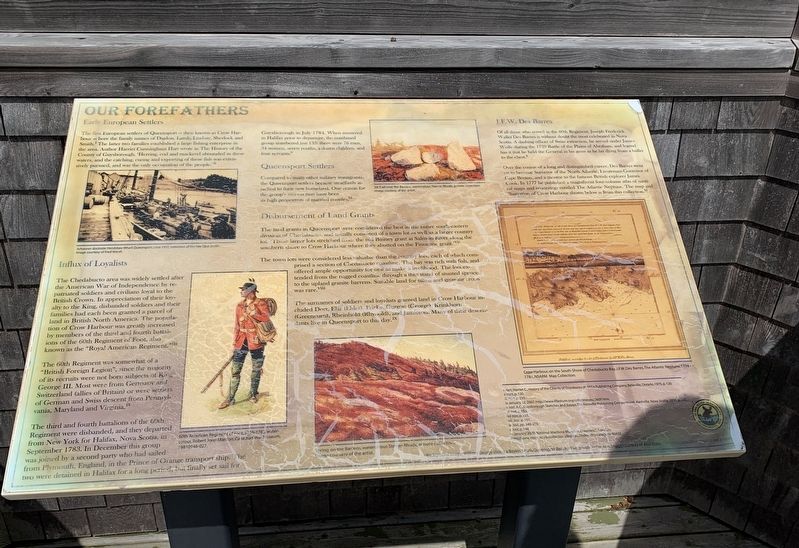Queensport in Guysborough County, Nova Scotia — The Atlantic Provinces (North America)
Our Forefathers
Early European Settlers
The first European settlers of Queensport -- then known as Crow Harbour – bore family names of Digdon, Lamb, Lindsay, Sherlock, and Smith. The latter two families established a large fishing enterprise in the area. Author Harriet Cunningham Hart wrote in The History of the County of Guysborough, “Herring, cod, and mackerel abounded in these waters, and the catching, curing, and exporting of these fish was extensively pursued, and was the only occupation of the people.
Influx of Loyalists
The Chedabucto area was widely settled after the American War of Independence by repatriated soldiers and civilians loyal to the British Crown. In appreciation of their loyalty to the King, disbanded soldiers and their families had each been granted a parcel of land in British North America. The population of Crow Harbour was greatly increase by members of the third and fourth battalions of the 60th Regiment of Foot, also known as the “Royal American Regiment.”
The 60th Regiment was somewhat of a “British Foreign Legion”, since the majority of its recruits were not born subjects of the King George III. Most were from Germany and Switzerland (allies of Britain) or were settlers of German and Swiss descent from Pennsylvania, Maryland, and Virginia. The third and fourth battalions of the 60th Regiment were disbanded and they departed from New York for Halifax, Nova Scotia in September, 1783. In December this group was joined by a second party who had sailed from Plymouth, England in the Prince of Orange transport ship. The two were detained in Halifax for a long period, but finally set sail for Guysborough in July 1784. When mustered in Halifax prior to departure, the combined group numbered just 133: there were 76 men, 34 women, seven youths, a dozen children, and four servants.
Queensport Settlers
Compared to many other military immigrants, the Queensport settlers became steadfastly attached to their new homeland. One reason for the group’s success may have been its high proportion of married couples.
Disbursement of Land Grants
The land grants in Queensport were considered the best in the entire south-eastern division of Chedabucto, and usually consisted of a town lot as well as a larger country lot. These larger plots stretched from the old Binnery grant at Salmon River along the southern shore to Crow Harbour where they abutted on the Finucane grant. The town lots were considered less valuable than the country lots, each of which comprised a section of Chedabucto coastline. The bay was rich with fish, and offered ample opportunity for one to make a livelihood. The lots extended from the rugged coastline, through a thin stand of stunted spruce to the upland granite barrens. Suitable land for tilling and growing crops was rare.
The surnames of soldiers and loyalists granted land in Crow Harbour included Dort, Elar (Ehler), Gurgon (George), Krinkhorn (Greencourt) Rhienhold (Rhynold), and Jamieson. Many of their descendants live in Queensport to this day.
J.F.W. Des Barres
Of all those who served in the 60th Regiment, Joseph Frederick Wallet Des Barres is without doubt the most celebrated in Nova Scotia. A dashing officer of Swiss extraction, he served under James Wolfe during the 1759 Battle of the Plains of Abraham and legend has it that he held the General in his arms as he lay dying from a bullet to the chest.
Over the course of a long and distinguished career, Des Barres went on to become Surveyor of the North Atlantic, Lieutenant-Governor of Cape Breton, and a mentor to the famous British explorer James Cook. In 1777 he published a magnificent four-volume atlas of nautical maps and renderings entitled “the Atlantic Neptune.” The map and illustration of Crow Harbour shown below is from this collection.
References were not transcribed.
Photos and illustrations (starting top left and going clockwise):
Schooner dockside, Hendsbee Wharf, Queensport, circa 1927
Jet trail over the Barrens, watercolour , Steven Rhude
Crow Harbour, on the South Shore of Chedabucto Bay
Spring on the Barrens, watercolour Steven Rhude
60th American Regiment of Foot 1755-1783, watercolour Robert Marrion
Erected by Guysborough Municipality.
Topics. This historical marker is listed in these topic lists: Military • Settlements & Settlers. A significant historical month for this entry is July 1784.
Location. 45° 20.34′ N, 61° 15.924′ W. Marker is in Queensport, Nova Scotia, in Guysborough County. Marker is on Marine Drive (Nova Scotia Route 16), on the left when traveling east. Touch for map. Touch for directions.
Other nearby markers. At least 8 other markers are within 13 kilometers of this marker, measured as the crow flies. Queensport, Guysborough County (here, next to this marker); #5 Radar Unit R.C.A.F Station (approx. 7.9 kilometers away); We Will Remember/Nous Nous Souviendrons (approx. 8 kilometers away); Captain Savalette (approx. 10.6 kilometers away); Welcome to Place Savalette (approx. 10.6 kilometers away); The Voyage of Prince Henry Sinclair (approx. 11.6 kilometers away); Folklore & Trivia (approx. 12.2 kilometers away); Port Felix (approx. 12.2 kilometers away).
Credits. This page was last revised on October 7, 2019. It was originally submitted on October 7, 2019, by Steve Stoessel of Niskayuna, New York. This page has been viewed 214 times since then and 17 times this year. Photo 1. submitted on October 7, 2019, by Steve Stoessel of Niskayuna, New York. • Andrew Ruppenstein was the editor who published this page.
